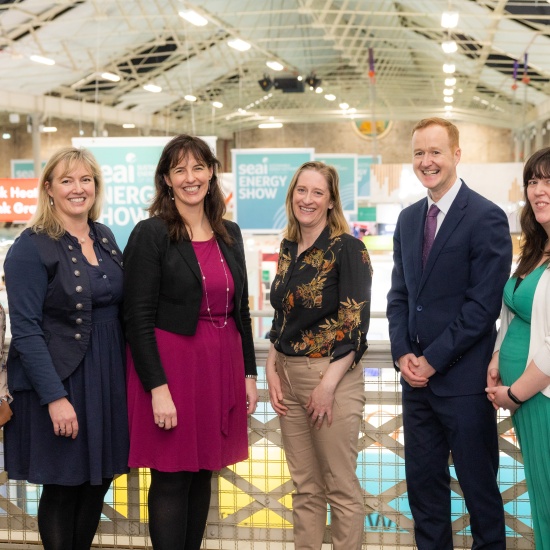Recognising change as a good thing
As the Sustainable Energy Authority of Ireland (SEAI) we are responsible for collecting, analysing, and publishing key data on Ireland's energy supply and demand.

Parallel to this role, and as important, is ensuring this data is accessible, that it makes sense, that we tell its story. Last week our statistics team were preparing to publish key energy data, and I was struck by how hard this is and has been for climate action. Look at the passion, and often despair, of the authors of Intergovernmental Panel on Climate Change (IPCC) reports as they spill fact after fact of impending impacts if action is taken too slowly, or not at all. It's such a complex canvas of challenges and solutions, and everything that can be done has strengths and weaknesses associated with it.
We have just published the Interim Energy Balance 2021. It's important to know and understand where and how we are using energy nationally and how we are generating energy to meet that demand. These data form part of the essential evidence base that underpins and informs national actions and policy to address climate change. It is data that SEAI publishes regularly yet publishing this information in 2022 brings a new significance.
Time of change
In 2021 we witnessed Ireland commit to the most ambitious and tangible measures to date in our efforts to address climate action. The carbon budgets, a key part of the roadmap of actions identified in the Climate Action and Low Carbon Development Act 2021, commit Ireland to a legally binding target of net-zero emissions by no later than 2050, and a cut of 51% by 2030. Bringing this into focus, the Climate Change Advisory Council called to have a 4.8% annual reduction in CO2 every year from 2021-2025 - a call that sailed through Dáil approval, without a vote.
In 2021, Ireland's energy use increased by 4.3% compared to 2020.
In 2020, our lives were turned upside down. The COVID-19 pandemic shook our normality in many ways. Our skies were noticeably empty of aircraft, our busiest roads were vacant, and many of our homes became offices and schools. While we experienced many hardships, much of this activity supported a decrease in our energy use in 2020. It demonstrated the impact of collective societal change, and a change that the public broadly understood and worked together to deliver, fast.
The Interim Energy Balance demonstrates our return to oil-product use, as normal life began to reset and travel restrictions lifted in 2021. It's easy to understand an increase in demand off the base of 2020, but it underlines the challenges with Ireland's high dependency on imported fossil fuels and how we need to change quickly.
The energy-related CO2 emissions also increased, and at a higher rate than energy use, at 6.3%. We experienced periods of time where it was less windy, and less rain fell, which resulted in less electricity from renewable sources. This was coupled with some gas-fired generation stations being offline due to maintenance and we had to use more coal and oil for electricity generation. These are more carbon intensive fuels and led to higher emissions.
Important questions
Questions that have arisen since the publication of the data are reasonable. For example, what happens when we achieve our target for wind energy and the wind doesn't blow? The national target is to power 80% of our electricity supply from renewable sources. In short, the 2021 Climate Action Plan includes extensive actions to realise significant deployment of onshore and offshore wind, solar PV and bioenergy.
Importantly the plan also sets out a number of actions relevant to energy storage, including development of a policy framework and a roadmap for hydrogen. In the same way as we built infrastructure and policies to ensure we could readily store fossil fuels at energy generation sites as electrification of the State took place, we now need to build and plan for renewable energy storage. This is an essential part of the national plan to realise our renewable energy resources while mitigating the variability in their supply into the future.
Other questions raised relate to the genuine concern over the impending and real time impact on our energy security as a result of the war and humanitarian crisis in Ukraine. The 2021 emissions are clear signals of how important it is to deliver the actions identified in our national Climate action Plan, without delay. The reasons to reduce fossil fuel dependency are also clear, the most secure unit of energy is the one we either don't use, or that we source from Irish renewables. Our actions need to focus on being as energy efficient as possible across all our energy use and shifting to renewables and technologies that use this clean energy quickly.
Climate action
Climate action is not often seen as easy. With so many questions, and only a certain capacity or appetite to absorb answers, we need to concentrate on the outcome, the benefit of change for all of us and the possibilities that change brings. It's true, climate action is not easy, we have a lot to do but we have so much to benefit from. Harnessing our collective action to move away from fossil fuels will create a better future for Ireland, with improved air quality, more comfortable homes, more vibrant communities and more sustainable industries and jobs. We can be the change that our younger generation and planet want and need. We've shown it can be done before, and we have no time to lose.
Read about the Interim Energy Balance 2021 Learn how to reduce your energy use



